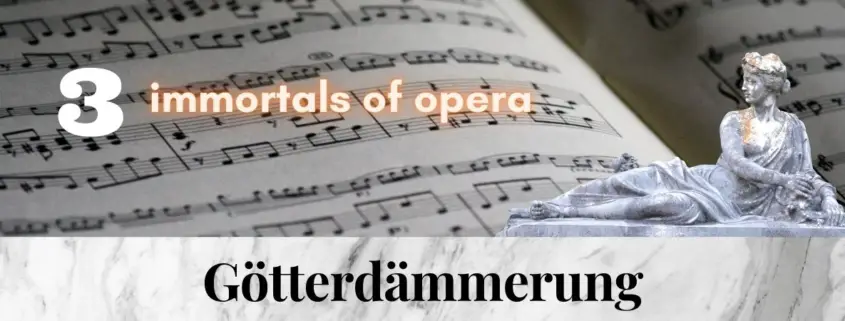The Ring of the Nibelung is a total work of art on a par with works of world literature such as Homer’s Iliad or Dante’s Divina commedia. It is astonishing how homogeneous this work appears to us, which was created over a period of 25 years and in a complex process of development. Twilight of Gods (Götterdämmerung) is an opera with grandiose images and concludes this work with a gigantic finale.
The farewell scene
The farewell scene of Siegfried and Brünnhilde is one of the highlights of the Ring. It begins with Brünnhilde’s tender motif that no longer shows her as a Valkyrie, but as a woman:
Brünnhilde awakes Siegfried, and his heroic motif resounds jubilantly in the brass:
Musical quote: Siegfrieds Hero motif
You can find this great scene in the playlist in two versions. The first one is from the famous Boulez/Chéreau cycle from Bayreuth.
Zu neuen Taten (1) – Jones / Jung
The unique mass scene of the Gibichung
Hagen swears to it and Alberich leaves him. Soon Siegfried appears and announces that he appeared at Brünnhilde’s in Gunther’s shape and could change with Gunther unnoticed in the fog of dawn. He assures Gutrune that he had not touched Brünnhilde and announces the imminent arrival of Gunther and Brünnhilde. Cheering, Gutrune agrees to the imminent wedding. Hagen calls the people of Gibichung together to offer the king and his bride a worthy reception and to celebrate the upcoming double wedding. He admonishes the soldiers to assist Gunther’s bride.
This scene is of ghostly savagery. Hagen’s call for a wedding “Hoihoo” is not in major, his voice forms a tritone with the basses. Thus his horn sounds, his calls and the male choir create an almost brutal atmosphere, which is whipped up over a period of almost 10 minutes. In the recording below we hear a passage at 1:28 where ten different notes can be counted at the same time in the score, in other words: a completely atonal passage! Added to this are the agitated tremolos in the basses. With the greatest pathos the choir shouts “Hail to thee and thy bride”, the first choral scene of the entire ring!
Hoiho! Hoihoo! (great scene with horns and choir) – Halfvarson
Siegfried’s funeral march
Siegfried is carried to the halls of Gibichung with a solemn escort.
Siegfried’s Funeral March is another great symphonic poem of the Ring. Siegfried’s life passes by once again musically. Beethoven’s Funeral March from his 3rd Symphony probably served as the model for this section. Like the model, Siegfried’s Funeral March is in three parts (minor-major-minor). The climax is heard in the 3rd part where we once again hear Siegfried’s motives in the winds. In this part we hear the triumphant motif of Siegfried. Do you remember the horn motif ? It is practically the same, simply slowed down 4 times:
Musical quote: Siegfried’s Hero motif
We hear this piece in a version by Herbert von Karajan. Karajan himself only worked in Bayreuth for a short time. Despite the success of two productions in the early fifties, Wieland Wagner reproached him severely for his slow tempo and the loud accompaniment, which led to a lack of comprehensibility of the text. Karajan never went back to Bayreuth and moved the main part of his festival activities to Salzburg.
Trauermusik beim Tode Siegfrieds – Karajan







Leave a Reply
Want to join the discussion?Feel free to contribute!